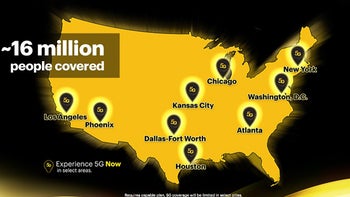Sprint 5G network coverage map: which cities are covered?

Latest update: July 8th. Sprint's 5G network is officially terminated as part of T-Mobile's integration process
Updated: Because things are about to change and T-Mo speeds will be drastically improved with the help of Sprint's former mid-band technology, you're advised to upgrade to a compatible phone. Your best options are the three members of Samsung's ultra-high-end Galaxy S20 family, which have proven far more popular than the likes of the Galaxy S10 5G anyway.
Read the full story: Sprint's 5G network is officially terminated as part of T-Mobile's integration process
Check T-mobile's 5G network coverage map
In contrast, rivals Verizon Wireless and AT&T rely on complicated millimeter-wave tech that delivers incredible speeds, but you get coverage only in very near proximity to a 5G node, something that Sprint harshly, but correctly describes as a "hotspot 5G network".
Sprint meanwhile kicked off its 5G network with a launch in four major US cities: its home market of Kansas City, as well as Atlanta, the Dalls-Fort Worth metropolitan area, and Houston. You don't have blanketed coverage all around these cities, so for example if you are driving you will notice that the network will often switch between 5G and 4G, but at least you don't need – we are exaggerating, but not much – to stand under a certain lamp post to get 5G coverage.
The carrier is also expected to launch in more big cities in the US in the near future and it's already got a few 5G phones on offer: the OnePlus 7 Pro 5G, the Samsung Galaxy S10 5G and the LG V50 ThinQ 5G.
In terms of speeds, you should expect an average of 203.8 Mbps for 5G, nearly 6X faster than Sprint’s average LTE download speed of 35.2 Mbps.
So where exactly do you get coverage? And how is that changing? We will be keeping a close look on Sprint's 5G expansion in this post and we will be updating it regularly, so make sure to bookmark it.
Here is a short summary of the cities where Sprint has 5G coverage:
- Atlanta, from College Park to Alpharetta, and from Marietta to Lawrenceville, including Peachtree Corners.
- Chicago, from the historic IL-64 in the north to Stevenson Expressway in the south, and as far as California Avenue in the west to the periphery of Lake Michigan in the east.
- Dallas-Fort Worth, including downtown and north Fort Worth and Euless, stretching across to north and northwest Dallas, including Plano, Richardson and Garland, and South Dallas.
- Houston, from downtown Houston to Memorial City Mall and City Centre Plaza, uptown Houston and northwest and south.
- Kansas City, from downtown Kansas City, Missouri, to Overland Park, Kansas, and other places in the KC Metro area.
- Los Angeles, from Marina del Rey to Downtown L.A., and West Hollywood to Culver City, and now in parts of Torrance, Southgate, Lancaster and Buena Park.
- New York City, in parts of Manhattan from Central Park to the southern tip, the Upper West Side and Harlem, the South Bronx; parts of Queens and Brooklyn; Hempstead, Long Island as well as Union City, Paterson, Lodi and East Orange in NJ.
- Phoenix, across the greater Phoenix metro area with service in parts of Phoenix, Tempe, Scottsdale, Glendale, parts of ASU, Chase Field and Mesa.
- Washington, D.C., around the U.S. Capitol, the White House, the National Mall, Foggy Bottom, Downtown, Penn Quarter/Metro Center, Dupont Circle, West End and Logan Circle. New additions include Fort Dupont and Deanwood in D.C., parts of Blandensburg and Fairmont Heights in Maryland, and parts of Bailey’s Crossroads and George Mason University in Virginia.
You can see the latest Sprint 5G Coverage Map here
*Sprint's website can only be accessed from the US.












Things that are NOT allowed: